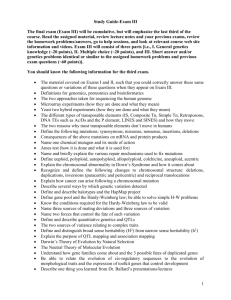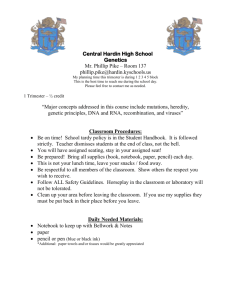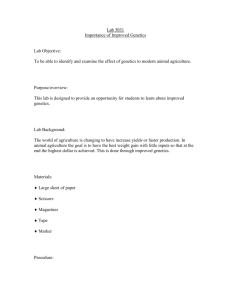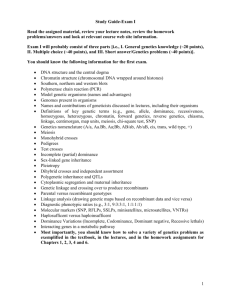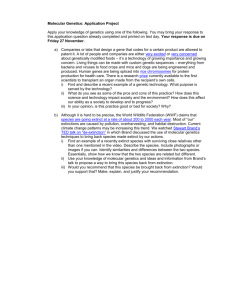BIOL 666 Human Genetic Concepts for Health Care
advertisement
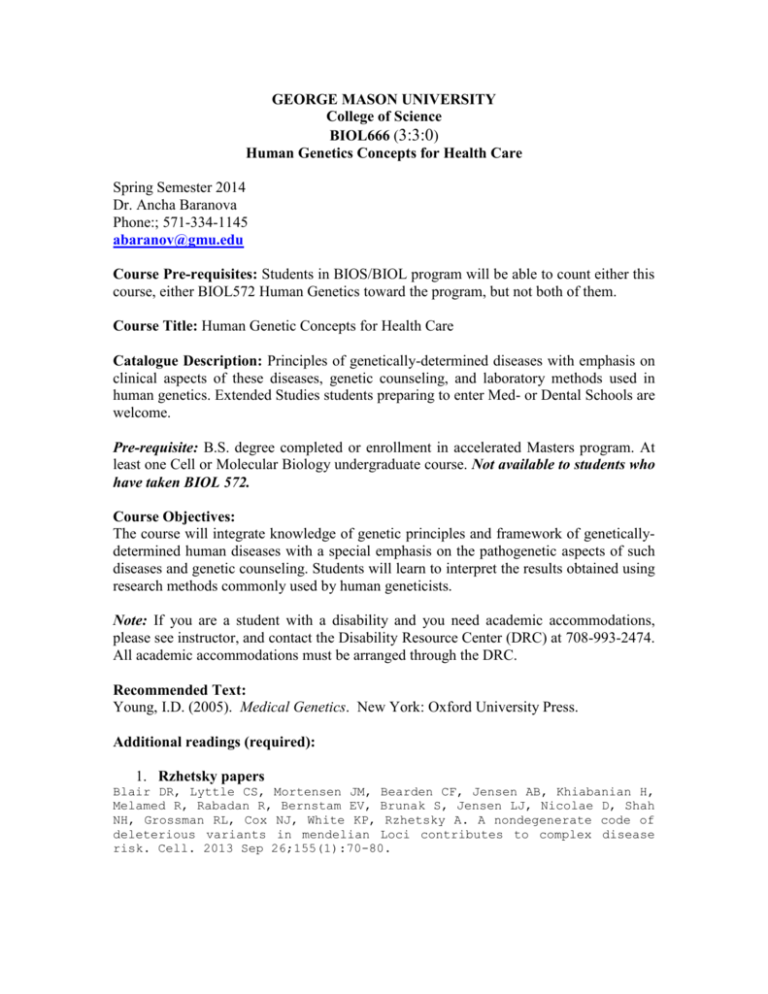
GEORGE MASON UNIVERSITY College of Science BIOL666 (3:3:0) Human Genetics Concepts for Health Care Spring Semester 2014 Dr. Ancha Baranova Phone:; 571-334-1145 abaranov@gmu.edu Course Pre-requisites: Students in BIOS/BIOL program will be able to count either this course, either BIOL572 Human Genetics toward the program, but not both of them. Course Title: Human Genetic Concepts for Health Care Catalogue Description: Principles of genetically-determined diseases with emphasis on clinical aspects of these diseases, genetic counseling, and laboratory methods used in human genetics. Extended Studies students preparing to enter Med- or Dental Schools are welcome. Pre-requisite: B.S. degree completed or enrollment in accelerated Masters program. At least one Cell or Molecular Biology undergraduate course. Not available to students who have taken BIOL 572. Course Objectives: The course will integrate knowledge of genetic principles and framework of geneticallydetermined human diseases with a special emphasis on the pathogenetic aspects of such diseases and genetic counseling. Students will learn to interpret the results obtained using research methods commonly used by human geneticists. Note: If you are a student with a disability and you need academic accommodations, please see instructor, and contact the Disability Resource Center (DRC) at 708-993-2474. All academic accommodations must be arranged through the DRC. Recommended Text: Young, I.D. (2005). Medical Genetics. New York: Oxford University Press. Additional readings (required): 1. Rzhetsky papers Blair DR, Lyttle CS, Mortensen JM, Bearden CF, Jensen AB, Khiabanian H, Melamed R, Rabadan R, Bernstam EV, Brunak S, Jensen LJ, Nicolae D, Shah NH, Grossman RL, Cox NJ, White KP, Rzhetsky A. A nondegenerate code of deleterious variants in mendelian Loci contributes to complex disease risk. Cell. 2013 Sep 26;155(1):70-80. Iossifov I, Zheng T, Baron M, Gilliam TC, Rzhetsky A. Genetic-linkage mapping of complex hereditary disorders to a whole-genome molecularinteraction network. Genome Res. 2008 Jul;18(7):1150-62. 2. Goriely papers Goriely A, McGrath JJ, Hultman CM, Wilkie AO, Malaspina D. "Selfish spermatogonial selection": a novel mechanism for the association between advanced paternal age and neurodevelopmental disorders. Am J Psychiatry. 2013 Jun 1;170(6):599-608. Goriely A, Wilkie AO. Paternal age effect mutations and selfish spermatogonial selection: causes and consequences for human disease. Am J Hum Genet. 2012 Feb 10;90(2):175-200. 3. Snyder papers (iPOP) Li-Pook-Than J, Snyder M. iPOP goes the world: integrated personalized Omics profiling and the road toward improved health care. Chem Biol. 2013 May 23;20(5):660-6. Chen R, Mias GI, Li-Pook-Than J, Jiang L, Lam HY, Chen R, Miriami E, Karczewski KJ, Hariharan M, Dewey FE, Cheng Y, Clark MJ, Im H, Habegger L, Balasubramanian S, O'Huallachain M, Dudley JT, Hillenmeyer S, Haraksingh R, Sharon D, Euskirchen G, Lacroute P, Bettinger K, Boyle AP, Kasowski M, Grubert F, Seki S, Garcia M, Whirl-Carrillo M, Gallardo M, Blasco MA, Greenberg PL, Snyder P, Klein TE, Altman RB, Butte AJ, Ashley EA, Gerstein M, Nadeau KC, Tang H, Snyder M. Personal omics profiling reveals dynamic molecular and medical phenotypes. Cell. 2012 Mar 16;148(6):1293-307. Course Grading : 1. Exams (Two Mid-terms and Final) 2. Research Paper: Each student will write a paper that meets his/her educational or research objectives. The topic of the paper will be pre-approved by the instructor. This document shall contain a critical analysis of genetic and environmental component for one human disease and future direction for research of the subject. The paper should be written according to the full manuscript reference format identified by the journal of choice, e.g., The American Journal of Human Genetics. 3. Peer Evaluation of Research Papers: Students will also peer-evaluate the papers submitted by other students in the class (each of the students will cross evaluate 3 papers of their classmates). The form for peer-evaluation can be found at the end of the syllabus. The website for the GMU honor code: http://www.gmu.edu/facstaff/handbook/aD.html Evaluation will be based upon: Closed Book Exams 70% (15% Mid-term, 15% Mid-term, 40% Final exam) Written Paper 20% Critique of the Written Papers 10% CLASS STRUCTURE Each week there will be a lecture on a certain molecular genetics concept (3hrs) that will be illustrated with clinically relevant examples. Course Schedule Week WEEK 1 WEEK 2 WEEK 3 WEEK 4 WEEK 5 WEEK 6 WEEK 7 WEEK 8 WEEK 9 WEEK 10 WEEK 11 WEEK 13 WEEK 14 FINAL EXAM WEEK Activity Lecture 1. Acute and chronic diseases: blurry borders. EBV infection as an example. Genetic classification of human diseases. Family studies, twin studies, adoption studies. Polygenic inheritance. Heritability. Genes and Environment. “Liability-Threshold model”. Susceptibility genes. Common disease-common variant (CDCV) hypothesis. Linkage and association. Lecture 2. Examples of multifactorial diseases: detailed analysis. 1. Alzheimer disease 2. Coronary Artery disease 3. Diabetes Type I (childhood onset) 4. Diabetes type II (adult onset) 5.Hirschprung disease 6. Neural tube defects 7. Schizophrenia Rzetsky papers. Direct-to-Consumer (DTC) genetic testing. Lecture 3. Mutations and their consequences to expression of the gene or function of its product. Functional types of mutations, loss and gain of function. Spontaneous and induced mutations. Mutagens. Lecture 3 continued. Instability of the human genome. Paternal gain of mutations. Goriely papers. Common types of mutations in DNA. Rate of mutations in humans. Mutations vs. Aneuploidy. Truncation selction in human populations. Forced gain of mutations. HPRT Assay. Comet assay. Environmental carcinogens.DNA repair and DNA checkpoints. Ataxia-Telangioectasia. Exam 1. Lecture 4. Genetics of human development. Human reproduction as an inefficient process. Critical periods for developmental defects. Classification of birth defects. Teratogenesis. Hox and Pax genes. FGF pathway. Sonic hedgehog pathway. Neural crest cell migration network. Sex determination pathway. Lecture 5. Chromosomal abnormalities in humans. Ploidy. Karyotype. Methods of chromosome analysis. Chromosome territories. Meiosis. Oogenesis and spermatogenesis. Aneuploidy. Translocations. Down syndrome and other trisomies. Aneuploidy of sex chromosomes. Partical chromosome deletions. Williams syndrome. GENETICS PAPER IS DUE IN 4 PRINTED COPIES Lecture 5 continued. Chromosome instability syndromes. Telomeric instability. Lecture 6. Mendelian diseases. Important definitions of classic genetics. Expressivity. Penetrance. Consanguinity. X-chromosome inactivation. Anticipation. Mosaicism. Mitochondrial inheritance. GENETICS CRITIQUES ARE DUE Exam 2. Lecture 7. NextGen sequencing to find out gene defects. Exome sequencing for rare diseases. Recent advances. iPOP (Snyder) set of papers. Lecture 8. Human Polymorphisms. Types of Variations in Human Genome. Types of SNPs. Life cycles of SNPs and mutations. Disease risk and treatment response associated types of variation. ApoE4.TP53 Arg/Pro. Lecture 8 continued. Human Polymorphisms. Isoniazide, methotrexate, tamoximen response and its genetic modifiers. INDEL polymorphisms. ACE Alu-based indel. CCR5 indel. Copy Number Variations. CCL3L1. CNVs and autism. Allelic associations. Ankylosing spondylitis and B27 allele. Genome-wide association studies. HapMap project. Biomedical differences between chimps and human. Lecture 9. Obesity as an example of complex disease. Lecture 9 continued. Obesity as an example of complex disease. Lecture 10. REACTIVE OXIGEN SPECIES AS CONTRIBUTORS TO HUMAN DISEASES Review of topics. Guest lecture (if time permits) FINAL EXAM Guidelines for the Genetics Paper The overall purpose of this assignment is for the graduate student to explore genetic principles as related to his/her program of research, healthcare practice or healthcare education. The paper should be no longer than 10-12 pages, double-spaced. 1. A target journal is BMC Medical Genetics 2. The Author’s Guidelines should be obtained for the target journal. 3. The style of the paper should conform to Author’s Guidelines of the selected journal. 4. The paper must reflect proper spelling, grammar, logical organization, and referencing. 5. In addition to the classic references related to the topic, current references must be used. 6. A cover letter to the editor of the target journal as well as SELF-CHECKLIST (attached) should be submitted with the paper. This checklist will be used for grading of your paper by the teacher. Every line item will be evaluated on scale from 0 to 10. The Honor Code must be upheld in the writing of the paper (meaning – no plagiarism). Student Peer Evaluation Form Please EXPAND this form to evaluate each genetics paper thoroughly. PEER REVIEW EVALUATION/CRITIQUE FORM (10% of the grade) (please write YOUR NAME at the bottom of every form your submitted) Grading will be based on the scale below with 0 being completely unclear and 10 being clearly articulated. Constructive explanations are an important part of the evaluation. 1. Title of the written project evaluate/ Name of the author of the written project 2. Please evaluate scientific argumentation and logical clarity f this research paper. Was the path of the logic of the author clear for you? 0 1 2 3 4 5 6 7 8 9 10 EXPLAIN the rationale of your evaluation. 3. Please evaluate whether author of the project was able to EXPAND existing scientific or societal concepts presented in the paper 0 1 2 3 4 5 6 7 8 9 10 EXPLAIN the rationale of your evaluation. 4. Please evaluate whether this paper synthesize the material or simply cites the somebody else’s papers without proper synthesis 0 1 2 3 4 5 6 7 8 9 10 EXPLAIN the rationale of your evaluation. 5. Please evaluate the likelihood that this manuscript will be accepted to peerreviewed (please, base your evaluation on the writing style and formatting of the manuscript) 0 1 2 3 4 5 6 7 8 9 10 EXPLAIN the rationale of your evaluation. 6. What were strong and weak sides of this paper? (What are your recommendations for writing/rewriting this paper?) ADDITONALLY, FILL THE CHECKLIST (Yes/No) ____ Purpose for manuscript is clearly identified. ____ A specific genetic problem is clearly described. ____ Research and analytical writings provide appropriate background for understanding the genetics of the problem. ____ Exploration of topic reflects critical and creative thinking. ____ Implications for readers of journal are addressed. ____ Sources are cited appropriately to support claims. (10 citations at least) ____ Content of paper is organized clearly, with subsections and appropriate transition between paragraphs and sections. ____ Style and length of paper are appropriate for journal. ____ Appropriate sentence structure, grammar, punctuation, spelling, and format (or alternative style required by target journal) are used. ____Appropriate cover letter accompanies manuscript. If you were a scientist starting further investigation of the disease and its treatments described in this paper, what would be your next steps? PLEASE OUTLINE YOUR RESEARCH PLAN (1 page)



